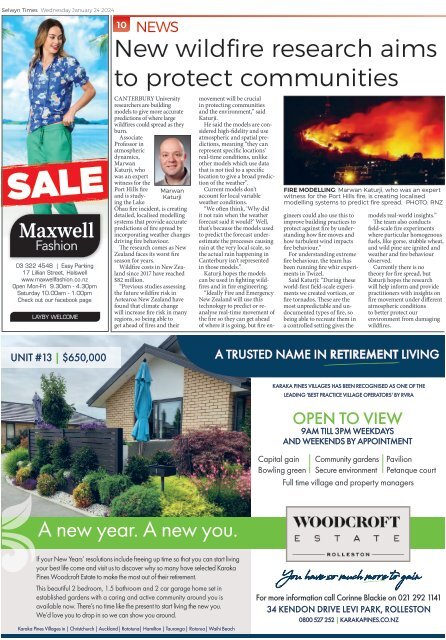Create successful ePaper yourself
Turn your PDF publications into a flip-book with our unique Google optimized e-Paper software.
<strong>Selwyn</strong> <strong>Times</strong> Wednesday <strong>January</strong> <strong>24</strong> 20<strong>24</strong><br />
10<br />
NEWS<br />
New wildfire research aims<br />
to protect communities<br />
SALE<br />
03 322 4548 | Easy Parking<br />
17 Lillian Street, Halswell<br />
www.maxwellfashion.co.nz<br />
Open Mon-Fri 9.30am - 4.30pm<br />
Saturday 10.00am - 1.00pm<br />
Check out our facebook page<br />
LAYBY WELCOME<br />
CANTERBURY University<br />
researchers are building<br />
models to give more accurate<br />
predictions of where large<br />
wildfires could spread as they<br />
burn.<br />
Associate<br />
Professor in<br />
atmospheric<br />
dynamics,<br />
Marwan<br />
Katurji, who<br />
was an expert<br />
witness for the<br />
Port Hills fire<br />
and is studying<br />
the Lake<br />
Marwan<br />
Katurji<br />
Ōhau fire incident, is creating<br />
detailed, localised modelling<br />
systems that provide accurate<br />
predictions of fire spread by<br />
incorporating weather changes<br />
driving fire behaviour.<br />
The research comes as New<br />
Zealand faces its worst fire<br />
season for years.<br />
Wildfire costs in New Zealand<br />
since 2017 have reached<br />
$82 million.<br />
“Previous studies assessing<br />
the future wildfire risk in<br />
Aotearoa New Zealand have<br />
found that climate change<br />
will increase fire risk in many<br />
regions, so being able to<br />
get ahead of fires and their<br />
FIRE MODELLING: Marwan Katurji, who was an expert<br />
witness for the Port Hills fire, is creating localised<br />
modelling systems to predict fire spread. PHOTO: RNZ<br />
movement will be crucial<br />
in protecting communities<br />
and the environment,” said<br />
Katurji.<br />
He said the models are considered<br />
high-fidelity and use<br />
atmospheric and spatial predictions,<br />
meaning “they can<br />
represent specific locations’<br />
real-time conditions, unlike<br />
other models which use data<br />
that is not tied to a specific<br />
location to give a broad prediction<br />
of the weather”.<br />
Current models don’t<br />
account for local variable<br />
weather conditions.<br />
“We often think, ‘Why did<br />
it not rain when the weather<br />
forecast said it would?’ Well,<br />
that’s because the models used<br />
to predict the forecast underestimate<br />
the processes causing<br />
rain at the very local scale, so<br />
the actual rain happening in<br />
Canterbury isn’t represented<br />
in those models.”<br />
Katurji hopes the models<br />
can be used in fighting wildfires<br />
and in fire engineering.<br />
“Ideally Fire and Emergency<br />
New Zealand will use this<br />
technology to predict or reanalyse<br />
real-time movement of<br />
the fire so they can get ahead<br />
of where it is going, but fire engineers<br />
could also use this to<br />
improve building practices to<br />
protect against fire by understanding<br />
how fire moves and<br />
how turbulent wind impacts<br />
fire behaviour.”<br />
For understanding extreme<br />
fire behaviour, the team has<br />
been running fire whir experiments<br />
in Twizel.<br />
Said Katurji: “During these<br />
world-first field-scale experiments<br />
we created vortices, or<br />
fire tornados. These are the<br />
most unpredictable and undocumented<br />
types of fire, so<br />
being able to recreate them in<br />
a controlled setting gives the<br />
models real-world insights.”<br />
The team also conducts<br />
field-scale fire experiments<br />
where particular homogenous<br />
fuels, like gorse, stubble wheat,<br />
and wild pine are ignited and<br />
weather and fire behaviour<br />
observed.<br />
Currently there is no<br />
theory for fire spread, but<br />
Katurji hopes the research<br />
will help inform and provide<br />
practitioners with insights on<br />
fire movement under different<br />
atmospheric conditions<br />
to better protect our<br />
environment from damaging<br />
wildfires.<br />
UNIT #13 | $650,000<br />
A TRUSTED NAME IN RETIREMENT LIVING<br />
KARAKA PINES VILLAGES HAS BEEN RECOGNISED AS ONE OF THE<br />
LEADING ‘BEST PRACTICE VILLAGE OPERATORS’ BY RVRA<br />
OPEN TO VIEW<br />
9AM TILL 3PM WEEKDAYS<br />
AND WEEKENDS BY APPOINTMENT<br />
Capital gain Community gardens Pavilion<br />
Bowling green Secure environment Petanque court<br />
Full time village and property managers<br />
A new year. A new you.<br />
If your New Years’ resolutions include freeing up time so that you can start living<br />
your best life come and visit us to discover why so many have selected Karaka<br />
Pines Woodcroft Estate to make the most out of their retirement.<br />
This beautiful 2 bedroom, 1.5 bathroom and 2 car garage home set in<br />
established gardens with a caring and active community around you is<br />
available now. There’s no time like the present to start living the new you.<br />
We’d love you to drop in so we can show you around.<br />
Karaka Pines Villages in | Christchurch | Auckland| Rototuna| Hamilton | Tauranga | Rotorua| Waihi Beach<br />
For more information call Corinne Blackie on 021 292 1141<br />
34 KENDON DRIVE LEVI PARK, ROLLESTON<br />
0800 527 252 | KARAKAPINES.CO.NZ


















